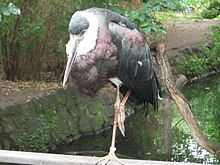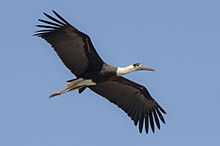Woolly-necked stork
| Woolly-necked stork | |
|---|---|
| | |
| Mangaon, Raigad, Maharashtra India | |
| Conservation status | |
| Scientific classification | |
| Kingdom: | Animalia |
| Phylum: | Chordata |
| Class: | Aves |
| Order: | Ciconiiformes |
| Family: | Ciconiidae |
| Genus: | Ciconia |
| Species: | C. episcopus |
| Binomial name | |
| Ciconia episcopus Boddaert, 1783 | |
The woolly-necked stork, bishop stork or white-necked stork (Ciconia episcopus) is a large wading bird in the stork family Ciconiidae. It can also be known as the episcopos or mannickjore.
Description

The woolly-necked stork is a large bird, typically 85 cm tall. It is glistening black with black "skull cap", white neck and white lower belly. The upper parts are glossed dark green, and the breast and belly have a purple hue.It has long red legs and heavy blackish bill. Sexes are alike. Juvenile birds are duller versions of the adult.
Distribution and habitat
It is a widespread tropical species which breeds in Asia, from India to Indonesia, and also in Africa. It is a resident breeder in wetlands with trees.
Behavior

The woolly-necked stork is a broad winged soaring bird, which relies on moving between thermals of hot air for sustained long distance flight. Like all storks, it flies with its neck outstretched.
Diet
The woolly-necked stork walks slowly and steadily on the ground seeking its prey, which like that of most of its relatives, consists of amphibians, small reptiles and large insects. African birds are attracted to bush fires.
Breeding
The large stick nest is built in a forest tree, and two to five eggs form the typical clutch. This stork is usually silent, but indulges in mutual bill-clattering when adults meet at the nest.
Taxonomy
African birds, C. e. microscelis, have the head mainly black, but the nominate Asian race, C. e. episcopus, has the head mainly white except for a darker area around the eyes. Eastern Indonesian birds belong to a third form, C. e. neglecta.
The bird derives its scientific species name from the black and white vestments formerly worn by clerics.
Conservation
The woolly-necked stork is one of the species to which the Agreement on the Conservation of African-Eurasian Migratory Waterbirds (AEWA) applies.
Different views & aspects
-
_with_Black-headed_Ibises_W2_IMG_9730.jpg)
With black-headed ibis and painted stork at Pocharam lake, Andhra Pradesh, India
-

-

-

-

References
- ↑ BirdLife International (2012). "Ciconia episcopus". IUCN Red List of Threatened Species. Version 2013.2. International Union for Conservation of Nature. Retrieved 26 November 2013.
- Birds of The Gambia by Barlow, Wacher and Disley, ISBN 1-873403-32-1
- Birds of India by Grimmett, Inskipp and Inskipp, ISBN 0-691-04910-6
External links
| Wikimedia Commons has media related to Ciconia episcopus. |
| Wikispecies has information related to: Ciconia episcopus |
- Woolly-necked Stork Ciconia episcopus - BirdLife International
- Woolly-necked Stork videos and photos - Internet Bird Collection
- Woollynecked Stork - The Atlas of Southern African Birds
| ||||||||||||||||||||||||||||||||||

